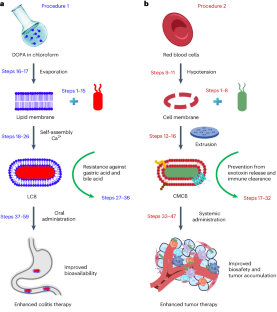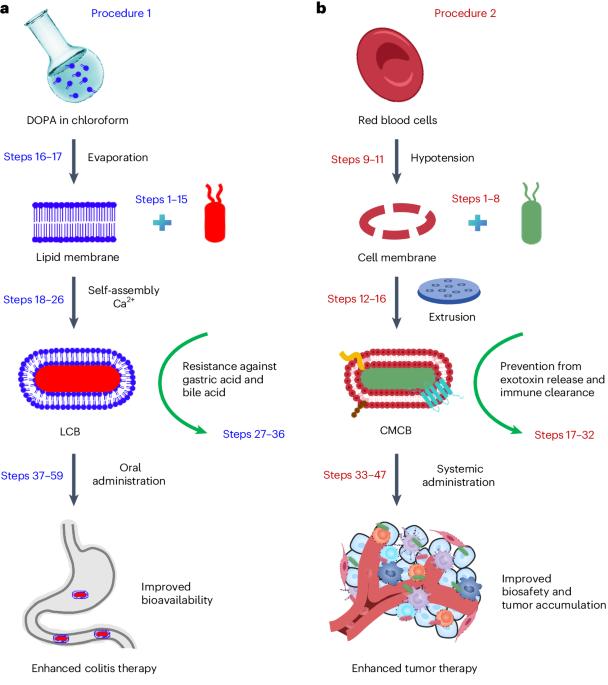Surface nanocoating of bacteria as a versatile platform to develop living therapeutics
IF 13.1
1区 生物学
Q1 BIOCHEMICAL RESEARCH METHODS
引用次数: 0
Abstract
Bacteria have been extensively utilized as living therapeutics for disease treatment due to their unique characteristics, such as genetic manipulability, rapid proliferation and specificity to target disease sites. Various in vivo insults can, however, decrease the vitality of dosed bacteria, leading to low overall bioavailability. Additionally, the innate antigens on the bacterial surface and the released toxins and metabolites may cause undesired safety issues. These limitations inevitably result in inadequate treatment outcomes, thereby hindering the clinical transformation of living bacterial therapeutics. Recently, we have developed a versatile platform to prepare advanced living bacterial therapeutics by nanocoating bacteria individually via either chemical decoration or physical encapsulation, which can improve bioavailability and reduce side effects for enhanced microbial therapy. Here we use interfacial self-assembly to prepare lipid membrane-coated bacteria (LCB), exhibiting increased resistance against a variety of harsh environmental conditions owing to the nanocoating’s protective capability. Meanwhile, we apply mechanical extrusion to generate cell membrane-coated bacteria (CMCB), displaying improved biocompatibility owing to the nanocoating’s shielding effect. We describe their detailed preparation procedures and demonstrate the expected functions of the coated bacteria. We also show that following oral delivery and intravenous injection in mouse models, LCB and CMCB present appealing potential for treating colitis and tumors, respectively. Compared with bioengineering that lacks versatile molecular tools for heterogeneous expression, the surface nanocoating technique is convenient to introduce functional components without restriction on bacterial strain types. Excluding bacterial culture, the fabrication of LCB takes ~2 h, while the preparation of CMCB takes ~5 h. This protocol adds a surface nanocoating to bacteria to improve bioavailability and reduce side effects for enhanced microbial therapy. Living bacterial therapeutics are produced by nanocoating bacteria individually via either chemical decoration or physical encapsulation.


细菌表面纳米涂层是开发活体疗法的多功能平台。
细菌具有独特的特性,如基因可操作性、快速增殖和针对疾病部位的特异性,因此被广泛用作治疗疾病的活体疗法。然而,各种体内损伤会降低已用药细菌的活力,导致总体生物利用率较低。此外,细菌表面的先天抗原以及释放出的毒素和代谢物也可能会引起不必要的安全问题。这些限制不可避免地会导致治疗效果不佳,从而阻碍活细菌疗法的临床转化。最近,我们开发了一种多功能平台,通过化学装饰或物理封装将细菌单独纳米包覆,制备先进的活细菌疗法,从而提高生物利用度,减少副作用,提高微生物治疗效果。在这里,我们利用界面自组装技术制备了脂膜包被细菌(LCB),由于纳米包被的保护能力,该细菌对各种恶劣环境条件的耐受性得到了提高。同时,我们还利用机械挤压法制备了细胞膜包被细菌(CMCB),由于纳米涂层的屏蔽作用,这种细菌的生物相容性得到了改善。我们描述了其详细的制备过程,并展示了涂覆细菌的预期功能。我们还表明,在小鼠模型中口服给药和静脉注射后,LCB 和 CMCB 分别具有治疗结肠炎和肿瘤的潜力。与缺乏异构表达的多功能分子工具的生物工程相比,表面纳米包衣技术可以不受细菌菌株类型的限制,方便地引入功能成分。不考虑细菌培养,制备 LCB 需要约 2 小时,而制备 CMCB 需要约 5 小时。
本文章由计算机程序翻译,如有差异,请以英文原文为准。
求助全文
约1分钟内获得全文
求助全文
来源期刊

Nature Protocols
生物-生化研究方法
CiteScore
29.10
自引率
0.70%
发文量
128
审稿时长
4 months
期刊介绍:
Nature Protocols focuses on publishing protocols used to address significant biological and biomedical science research questions, including methods grounded in physics and chemistry with practical applications to biological problems. The journal caters to a primary audience of research scientists and, as such, exclusively publishes protocols with research applications. Protocols primarily aimed at influencing patient management and treatment decisions are not featured.
The specific techniques covered encompass a wide range, including but not limited to: Biochemistry, Cell biology, Cell culture, Chemical modification, Computational biology, Developmental biology, Epigenomics, Genetic analysis, Genetic modification, Genomics, Imaging, Immunology, Isolation, purification, and separation, Lipidomics, Metabolomics, Microbiology, Model organisms, Nanotechnology, Neuroscience, Nucleic-acid-based molecular biology, Pharmacology, Plant biology, Protein analysis, Proteomics, Spectroscopy, Structural biology, Synthetic chemistry, Tissue culture, Toxicology, and Virology.
 求助内容:
求助内容: 应助结果提醒方式:
应助结果提醒方式:


